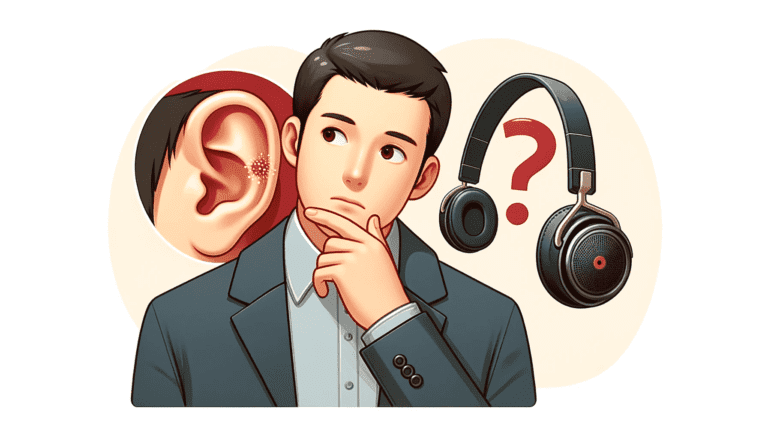Headphone dents have been a topic of discussion among music enthusiasts and headphone users for a long time.
In this article, we delve into the myths and facts surrounding the existence of headphone dents. By exploring common misconceptions and providing tips to prevent headphone dents, we aim to debunk the myth and provide clarity on this intriguing subject.
Are Headphone Dents Real?
Are headphone dents real? Yes, headphone dents are an actual phenomenon that many headphone users experience. Over time, prolonged use of headphones can cause indentations in the skin around the ear known as headphone dents. These dents form from the constant pressure of the headphones on the ears. The soft cartilage of the external ear is easily compressed and deformed, especially when subjected to sustained pressure over months or years of frequent headphone use.
Debunking the Myth of Headphone Dents
Understanding the Impact of Headphone Usage
The convenience and immersive experience offered by headphones have made them an integral part of daily life for many. However, it’s crucial to acknowledge the potential impacts of prolonged headphone use on our health. While the myth of headphone dents focuses on physical indentations, the real concern should be the auditory effects. Regular exposure to high volumes can lead to hearing impairment over time.
To understand the risks, let’s consider the factors that contribute to hearing health deterioration. The volume level, duration of exposure, and the frequency of use are all critical elements. Here’s a simple breakdown:
- Volume Level: Safe listening levels are typically below 85 decibels. Beyond this threshold, the risk of hearing damage increases.
- Duration of Exposure: The longer the exposure to loud sounds, the greater the potential for hearing loss.
- Frequency of Use: Daily use without adequate breaks can exacerbate the risk of auditory issues.
It’s important to use headphones responsibly to mitigate these risks. By managing the volume, limiting listening time, and taking regular breaks, we can enjoy our audio experiences without compromising our hearing health.
Exploring Common Misconceptions
When it comes to headphone usage, numerous myths circulate online and through word of mouth. One of the most pervasive myths is the idea that headphones can permanently ‘dent’ your skull. This misconception likely stems from the temporary indentations that can be felt after wearing headphones for an extended period.
However, the human skull is quite resilient, and the pressure exerted by headphones is typically insufficient to cause lasting changes. To illustrate, let’s address some common misconceptions with a list:
- Headphones cause permanent skull deformation: This is simply untrue. The skull is made of bone, which is much harder than the cushioning of headphones.
- Wearing headphones leads to hair loss: There is no scientific evidence to support this claim. Hair loss is generally caused by genetic factors, hormonal changes, or medical conditions.
- Frequent headphone use results in hearing damage: While excessive volume can indeed harm hearing, the headphones themselves are not inherently damaging if used responsibly.
It’s important to approach such claims with a critical eye and seek out reliable information. The title ‘Can Headphones REALLY Dent Your Head? Shocking Truth!’ may grab your attention, but the snippet ‘Contrary to popular belief, routine headphone use does not ‘dent’ your head’ reveals the truth behind sensationalism.
Tips to Prevent Headphone Dents
To avoid the notorious headphone dent, consider the following practical tips. First and foremost, choose headphones with a wider headband or those that distribute pressure more evenly across the head. For instance, headphones that go over the back of your head can be an effective solution to prevent dents.
When wearing headphones for extended periods, take regular breaks to relieve pressure. It’s also beneficial to adjust the headband to ensure it’s not too tight. If you’re using headphones with an adjustable band, periodically switch the position slightly to change the pressure points.
Here’s a quick checklist to keep in mind:
- Select headphones with a comfortable, wide headband
- Opt for designs that distribute pressure evenly
- Take breaks to reduce prolonged pressure
- Adjust the headband for a proper fit
- Rotate the position of the headband occasionally
By following these simple steps, you can enjoy your audio experience without the worry of developing a headphone dent.
Conclusion
In conclusion, the myths surrounding headphone dents have been debunked through a thorough examination of the facts. Despite common misconceptions, headphone dents are not a real phenomenon and are often the result of misunderstandings or misinterpretations. It is important to rely on accurate information and avoid spreading false claims. By understanding the truth behind headphone dents, we can appreciate the quality and durability of modern headphone designs without falling prey to unfounded beliefs.
Frequently Asked Questions
Are headphone dents a common issue with all types of headphones?
Headphone dents can occur with certain types of headphones, especially those with tight headbands or pressure points. However, not all headphones are prone to developing dents.
Can headphone dents affect the sound quality of the headphones?
In most cases, headphone dents do not significantly impact the sound quality. However, severe dents or damage to the drivers may alter the audio output.
How can I prevent headphone dents from occurring?
To prevent headphone dents, you can try adjusting the headband for a looser fit, avoiding excessive pressure on the headphones, and storing them in a protective case when not in use.
Are headphone dents covered under warranty by headphone manufacturers?
Warranty coverage for headphone dents varies among manufacturers. Some may consider dents as cosmetic damage and not covered under warranty.
Can headphone dents be repaired or fixed?
Minor headphone dents can sometimes be fixed by gently reshaping the affected area. However, severe dents may require professional repair or replacement of parts.
Are headphone dents a common issue reported by headphone users?
While some users may experience headphone dents, it is not a widespread issue reported by all headphone users. Factors such as headphone design and usage habits can contribute to the likelihood of dents.






